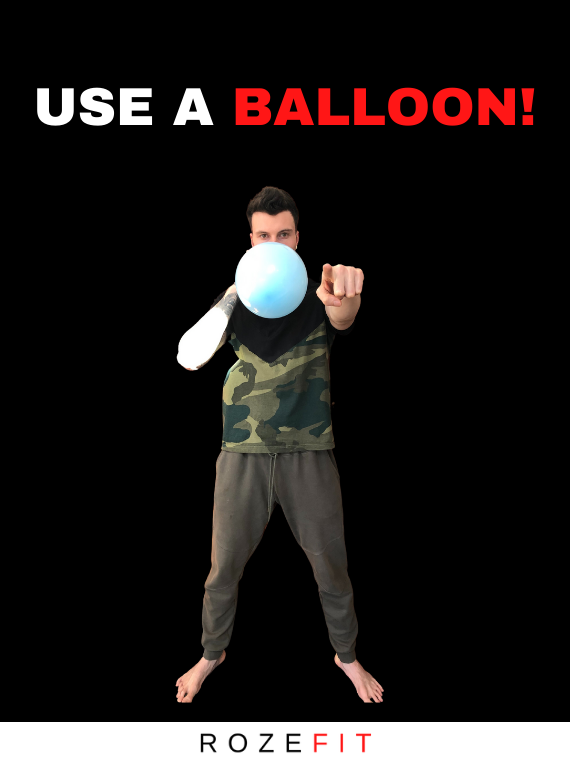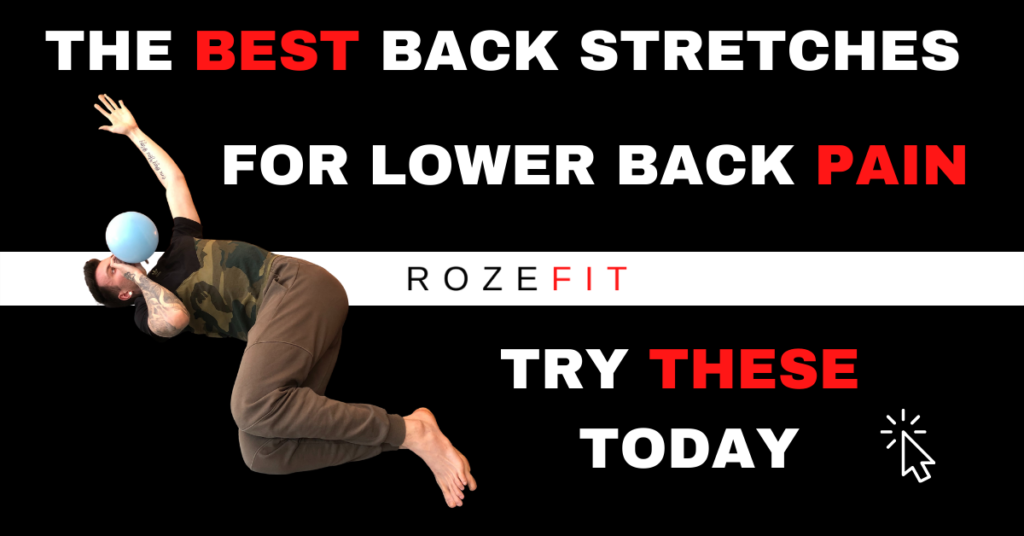Lower back pain is chronically on the rise worldwide and statistically will affect most people at some point in their life.
The majority of my clients have come to me with some sort of back pain – the causes ranging far and wide, from past sports injuries to muscular imbalances.
In fact, so many of my clients come to me asking Jakob, “how do I fix my back pain?” that I felt like I absolutely HAD to get this information out there for the public to learn about!
In this article, I am going to teach you the best back stretches for lower back pain.
Also, before we start – I’d love to hear your lower back pain story.
Please leave a comment and tell your story at the end of reading this article.
The Cause of Lower Back Pain
After years of treating lower back pain in my clients, I finally realized one thing:
The exact cause of the lower back pain is of less importance than finding a timely solution for the pain!
You see, the exact cause of the lower back pain may never totally be discovered despite diagnostic testing such as MRI or X-ray.
But the truth is, it really doesn’t matter. What does matter, is learning which exercises will help you get back to your regular life without agonizing pain.
If you go from one doctor to the next chasing the latest diagnosis, you may be doing more harm than good.
Lower Back Pain: What Matters Most
Catastrophizing is a real part of the pain process and it is time to shift your focus from why to how.
I have written an article here about how psychology impacts your pain experience.
It is well worth the read if you ever wondered how pain occurs and what you can do about it.
HOW are we going to implement the best back exercises for your lower back pain?
Everyone has different needs and I am by no means suggesting that all exercises are created equal.
Without a proper assessment, it is difficult to prescribe the exact workout perfect for you.
But what you can do is take a look at these unique techniques that have helped many of my clients throughout the years treat their back pain.
What matters most is experimenting with what works for your body!
In this article, I’m going to show you the best stretches for lower back pain.
I believe that these 3 workouts will help you immensely and the best part is that you can perform these lower back exercises at home!
So let’s get started.
Back Stretches for Lower Back Pain vs Stability Exercises for Back Pain
While stretches are some of the best exercises for back pain, I would also argue that a large percentage of people will benefit from stability exercises for back pain.
One is not necessarily better than the other, just a different side of the same coin.
Again, it depends on YOUR needs and what feels right.
Remember, you know your body better than anyone!
We will cover both here today. Also, there is a special bonus exercise that I guarantee you have never seen before if you keep reading.
So let’s go ahead and start with the mobility piece.
Remember to use your own body as your guide and check-in with yourself.
Does this feel good?
Does this not feel good?
What is your body telling you?
Let your intuition and sensation guide you as you experiment with these movements.
Side Rotation Stretch
This stretch focuses on thoracic spine mobility.
The thoracic spine is the top half of your back.
Specifically, T1-T12 as you may have seen it referred to like the picture in this article from the Sheperd Center.
But I thought you said these stretches are for your lower back?
Well, the relief is for your lower back – but the target is your upper back. Why?
In my experience, a lot of my clients suffering from lower back pain have some restriction in their thoracic spine, that is – a mobility restriction.
One that prevents proper rotation of the trunk, which is invariably a contributing factor to lower back pain.
When the thoracic spine cannot rotate properly, your lower back(lumbar spine) may take over and compensate for that lack of mobility.
And guess what? The lower back does not like to do the job of the upper back and so when it tries, it may result in painful compensation.
For this stretch, you want to keep your knees bent at least 90 degrees and both knees together.
Gently rotate your upper back and chest, looking in the direction of your hand as you twist.
Good.
Now only rotate as far as your body allows for. This is called “your end range” which just means the maximal degree of freedom that you have for that joint or joint segment.
Don’t force the stretch but rather rotate with gentle ease, just approaching the end range but without surpassing it. Perform 10 reps on each side for 3 sets. Frequency is key!
Try to get this one in 3x per day so your brain can begin to down-regulate the pain signals causing your lower back pain.
Side Bending Overhead Stretch
Next, we have the Side Bending Overhead Stretch.
For this one, you are going to cross your right leg behind your left and go up and overhead with the right arm, side-bending to the left side.
From here you are going to look at your right hand and take 8 breaths into your rib cage on the right side.
3x on this side and then switch it up to the other side.
Deep breathing is critical for this one as your breath is responsible for down regulating your sympathetic nervous system.
This is the part of the nervous system that keeps your low back muscles tight and engaged, ultimately contributing to your pain.
This movement helps train lateral flexion of the spine.
Lateral movements of the spine are of utmost importance to proper spinal mechanics.
Additionally, you will also be getting a great stretch through your quadratus lumborum.
According to Healthline, this is the deepest abdominal muscle and is located in your lower back on both sides of the spine.
It goes all the way from your last rib to the crown of the pelvis.
Positions for Lower Back Pain Relief

This is where the stability component comes in that I mentioned before.
If I had to pick one exercise for you to do today, this would be the single best exercise for lower back pain and it involves balloons.
I believe balloons are such a good tool to use when it comes to alleviating back pain that I wrote a free guide which you can have sent to you here in case you want to learn more about this proven strategy.
The WHY is a long one – so buckle up.
If you want to skip the long winded explanation, feel free to just watch the video and read the instructions.
But for those who really want to be educated about why this exercise is the single best exercise for lower back pain and the exact exercise that I use to treat all of my clients suffering from lower back pain, here we go:
How to Fix Back Pain with a Balloon

Balloons are a wonderful tool to modulate our nervous system and breathing patterns via the diaphragm.
When we use the diaphragm to breathe, we set our bodies up to begin moving from a neutral position, one that is not tense and scared.
Aside from this effect on the nervous system, it literally influences the way the rest of our body functions.
We can use the balloon to turn on the deep abdominal muscles which subsequently inhibit the extensor muscles that are often overactive during back spasms.
Furthermore, exhaling into the balloon while posteriorly tilting the pelvis (“tuck your butt”) depresses the rib cage and reduces this hyperextended position.
By aligning the pelvis with the rib cage via diaphragmatic breathing against an external cue (i.e. the balloon), we shut down sympathetic tone (think overly tense musculature).
Thus, we activate a more Parasympathetic state by which a neutral, relaxed state allows for better movement and more specifically improved myokinematics of the pelvis – arguably one of the largest contributors to lower back pain.
Pelvic Neutrality Breathing
Gently inhale through your nose, expanding your belly.
Then exhale all of the air out into the balloon with your mouth. Then PAUSE!
Bring your tongue to the roof of your mouth in order to trap the backflow of air.
Gently inhale through your nose and then exhale again, simultaneously releasing your tongue to allow for full exhalation.
Repeat this process until the balloon is fully expanded. Take a short break and repeat several sets.
So basically, we need to really emphasize the exhales through the mouth and inhales through the nose in order to create intra-abdominal stability and this stability translates to the back pain relief you are looking for.
The Ultimate Solution to Back Pain
The key solution to your back pain simply comes down to the consistency with which you perform these exercises.
There is no simple fix and your effort is paramount to getting out of pain.
But with a few simple strategies now in your toolbelt, you will be able to get started on your path to pain-free movement.
If there is one piece of advice that I would leave you with, it is – don’t chase a diagnosis, find a SOLUTION!
If you want to try something I guarantee you have not tried before then check out my free guide to fixing back pain by clicking here.
I believe access to resources and information is the key to solving our global pain pandemic.
If you are stuck on your journey and are tired of the same boring stretch recommendations from your doctor and physical therapist, give these unique balloon exercises a try and be sure to let me know how they have helped you.
As always, you can get in contact with me and I would be happy to guide you if you have any follow-up questions.
You can also tell your lower back pain story in the comments below and I will be sure to get back to you!
Who is Jakob Roze?
Jakob Roze is a Strength and Conditioning Coach and founder of RozeFit. His practice centers around empathic communication and relationship building. With an emphasis on pain-free, functional movement patterns and strength training, Jakob Roze assesses each individual’s needs and prescribes exercise modalities appropriately in order to facilitate long-term gains in strength and health. He draws from evidence-based approaches and applies the knowledge in a personalized fashion to facilitate body and lifestyle transformation amongst his clients.


